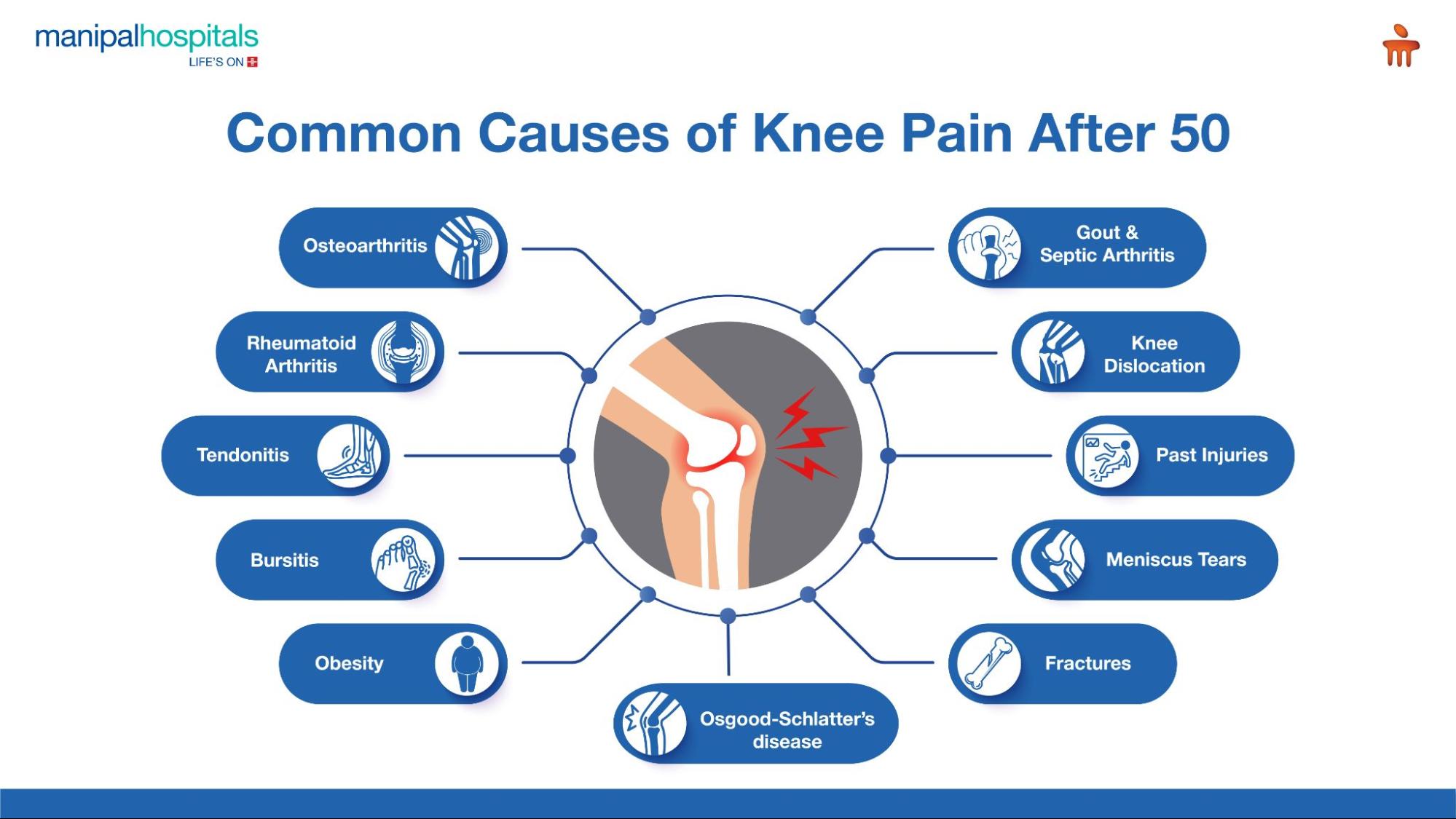Growing older comes with its own set of challenges, and knee pain is one of the most common problems, especially in adults over 50. Whether it’s a dull ache during morning walks, discomfort while climbing stairs, or stiffness when getting out of bed, it’s your knees signalling that something isn’t right. There can be several causes of knee pain, with osteoarthritis being the most common. The onset typically starts in the late 40s to mid-50s and sometimes even earlier. In India, the prevalence of knee osteoarthritis is around 28.7%, while globally, it affects approximately 365 million people, with 60% of them being women.
While knee pain after 50 may be common, it’s certainly not something you have to live with. Let’s explore the knee pain, effective home remedies and treatment to get rid of knee pain at home.
Synopsis
Knee Pain After 50: Normal Ageing or a Red Flag?
The knee is the largest joint in the body, formed where four bones meet, i.e., femur (thigh bone), tibia, patella (knee cap), and fibula. They together add to the weight-bearing capability of the knee and provide stability. With every step you take, the knee bears a considerable amount of pressure, which builds up throughout life, causing wear and tear, thereby making the joint ligaments and muscles weaker. Usually, the shock absorbers of the knees, called menisci and articular cartilage, start deteriorating with time, giving rise to knee pain.
Although knee pain becomes more common with age, especially after crossing 50, it is often worsened by factors such as being overweight and leading a sedentary lifestyle. However, persistent knee pain is not always just age-related. It can result from an injury, overuse, arthritis, or even infections. It’s important to get evaluated by an orthopaedic specialist to identify the underlying knee pain. With timely care and appropriate lifestyle modifications, knee pain can be effectively managed and, in many cases, even prevented. Even at 50, it's not too late to take steps to protect your knees as you age.
Knee Pain Causes

There can be many knee pain causes but understanding them helps in identifying the right treatment or remedy. Some of the most frequent causes include:
-
Osteoarthritis: It is a leading cause of knee pain in people over 50 years of age and results from to breakdown of cartilage. This leads to stiffness around the joints in the morning hours, swelling and knee pain.
-
Knee Injuries: A knee injury or a fall at a young age can cause long-term instability, which can flare up after 50, such as in the case of anterior cruciate ligament (ACL) injury.
-
Tendonitis: Due to overuse of the knee joint, the tendons can get inflamed, resulting in sore or painful knees.
-
Obesity: Having excess weight can put extra stress on the knees, boosting the cartilage wear and tear, resulting in chronic knee pain and discomfort.
-
Torn meniscus: The tough rubbery cartilage that protects the knee, called menisci, can tear up due to overweight and extensive workload, causing knee pain.
-
Bursitis: Inflammation may occur in the bursae, the small fluid-filled sacs that cushion the outside of your knee joint, causing knee pain, especially during movement.
-
Rheumatoid arthritis: This autoimmune condition can affect joints, showing more impact with age.
-
Osgood-Schlatter’s disease: In this, the bony lump below the knee cap gets swollen and painful during and after exercise, affecting children and young people.
-
Fractures: These are common and can occur after a fall or accident, causing pain in old age. Also, osteoporosis can lead to weaker bones, resulting in fractures and subsequent knee pain.
-
Knee Dislocation: The knee joint can get displaced, leading to blockage of blood flow to the leg, resulting in knee pain.
In addition, there can be many other knee pain causes such as patellar tendinitis, illiotibial band syndrome, Patellofemoral pain syndrome, gout, and septic arthritis.
How to Get Rid of Knee Pain?
Home Remedies for Knee Pain
Mild to moderate knee pain can often be treated at home using some easy and natural home remedies. If the pain is moderate to severe and does not get better with time, then getting medical advice is crucial.
Here are some natural and effective home remedies for knee pain:
-
Hot and Cold Therapy: Using a heating pad can help relieve pain by relaxing muscles and improving blood flow. Whereas, cold therapy helps reduce swelling and numbs sharp pain. You can alternate between heat and cold therapy.
-
Ginger Tea: Using ginger and turmeric tea can ease knee pain.
-
Warm Oil Massage: The knees can be massaged using warm mustard or coconut oil, which improves circulation and reduces stiffness.
-
RICE: Rest, ice, compression and elevation (RICE) technique can help in knee pain due to a fall, strain, sprain or a twisted leg.
-
Epsom Salt Soak: Soaking your legs in warm water with Epsom salt can relieve joint pain and reduce inflammation.
-
Herbal Ointments: Some over-the-counter herbal ointments can be used to relieve mild or occasional knee pain.
Tips for Knee Pain Treatment at Home
In addition to home remedies, these simple knee pain treatment at home methods can offer relief in case of mild pain. These include:
-
Indulge in low-impact exercises like cycling, walking, swimming, tai chi or yoga to boost knee strength and flexibility.
-
In case you are overweight and knee pain is affecting you, then focus on reducing body weight to reduce stress on your knees. Take professional help if needed.
-
Always wear shoes having good arch support and cushioning to avoid unnecessary strain on your knees.
-
Eat a diet rich in anti-inflammatory foods such as omega-3 fatty acids, nuts, leafy green vegetables, etc.
-
Taking adequate rest is essential if the knees are swollen or painful after activity.
When to See a Doctor
While self-care can be effective, don’t ignore signs that may need medical evaluation:
-
Persistent swelling, pain or redness
-
Pain that disrupts sleep
-
Difficulty walking or bending the knee
-
Popping or locking sensations in the joint
-
Signs of infection
-
Deformity
Early diagnosis and treatment by a professional in case of moderate to severe pain can prevent long-term damage.
Conclusion
The knee pain may sound normal after 50, but it doesn’t have to be your new normal. Understanding the various knee pain can help you in making the right choice of adopting home remedies for knee pain or going to a professional for treatment to lead an active, pain-free life.
Don’t let knee discomfort hold you back; listen to your body, make healthy choices, and seek professional help from orthopaedics at Manipal Hospitals, Mukundapur.
FAQ's
Yes, osteoarthritis is one of the most common causes of knee pain, especially in people over the age of 50. While it can develop at any age, it's more prevalent as you grow older, causing knee pain, stiffness, and reduced mobility, which can affect one or both knees.
To prevent knee pain after 50, focus on strengthening the muscles around the knees, maintain a healthy weight, engage in simple exercises like walking, cycling, swimming, etc, stay hydrated, and consider assistive devices when needed.
Yes, walking is generally good for the knees and can help in relieving knee pain, especially in the case of osteoarthritis. They strengthen muscles and also aid in weight management.
The best treatment will depend upon the severity and cause of the pain. The treatment options can be simple home remedies, the RICE technique, over-the-counter pain relievers, or, in more severe cases, surgery may be recommended. Consult an orthopaedic doctor for advice.
You can schedule an appointment with our orthopaedic specialist at Manipal Hospitals, Mukundapur, by contacting us or visiting our website.
Visit: https://www.manipalhospitals.com/mukundapur/specialities/orthopaedics/
Contact no: 033 6907 0001





















 7 Min Read
7 Min Read



















